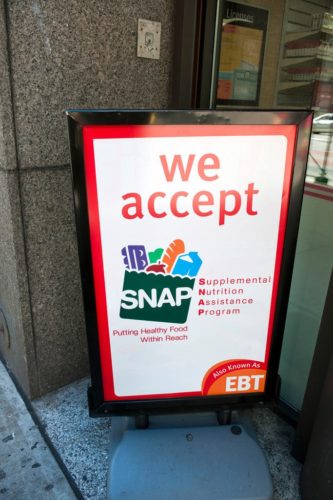
MADISON – Nearly 40,000 Wisconsinites would lose food benefits under a rule change President Donald Trump’s administration is pursuing.
The change would boost costs for Wisconsin taxpayers by millions of dollars a year because the state would have to upgrade the computer systems that administer the FoodShare program, retrain workers and more thoroughly scrutinize the assets of people who apply for benefits.
The computer upgrade would cost $2.3 million, according to the state Department of Health Services. Operational costs would rise by $17.7 million a year. State and local taxpayers would have to pick up about half of both sets of costs, with the federal government paying for the rest.
“The bottom line is you’d have more cost on bureaucracy and administration and fewer benefits going to Wisconsinites,” Democratic Attorney General Josh Kaul said.
Kaul and 23 other attorneys general sent a letter last week urging the U.S. Department of Agriculture not to implement the new rule for the Supplemental Nutritional Assistance Program, which is widely known as the food stamp program. In Wisconsin, it is called FoodShare.
Other Wisconsin Democrats, including Gov. Tony Evers and U.S. Sen. Tammy Baldwin, are fighting the proposed rule.
But U.S. Rep. Glenn Grothman, a Republican from Glenbeulah, argued the new rule would help ensure only the deserving receive benefits.
“A lot of people didn’t know that millionaires are eligible for food stamps,” he said. “I’m glad Donald Trump came along and decided to put a stop to it.”
Nearly 40 million people, including about 644,000 Wisconsinites, received food stamps in 2018. Like most states, Wisconsin provides food benefits to people who qualify for other government programs without performing additional income and asset tests.
The proposed rule would bar people in other programs from automatically qualifying for food stamps. Reviews of their income and assets would need to be conducted to ensure that, in most cases, their income is at or below 130% of the federal poverty level and they do not have liquid assets worth more than $2,250.
For a family of three, 130% of the federal poverty level is about $2,250 a month.
Agriculture Secretary Sonny Perdue said the proposed rule is meant to prevent wealthy people from qualifying for food stamps. He cited the example of Rob Undersander, a Minnesota man who conducted what he called a citizen’s audit of the food stamp program.
Undersander told Minnesota lawmakers last year he received about $300 a month in food stamps for 19 months despite having more than $1 million in property and retirement accounts, according to WCCO-TV and Forum News Service. He was able to qualify for those benefits because he had little income.
“What we’re trying to do is make it fair and equal across everyone, where everyone who qualifies for food stamps based on the rules that Congress has passed, both asset and income tests, can qualify just as they always have,” Perdue told reporters Tuesday at the World Dairy Expo in Madison. “Those people who become categorically eligible, as in that fellow from Minnesota who tested the system as a millionaire and qualified for food stamps, we don’t want that happening.”
But Kaul said the proposed rule would primarily hurt people who are struggling.
“The majority of people who are going to be affected are children and seniors,” the attorney general said. “Undermining food security for children and seniors … is cruel.”
Nearly 3 million food stamp recipients across the country would lose their benefits if the rule change went into effect, according to estimates by Perdue’s Department of Agriculture. The rule would also result in children losing access to school lunches because many schools automatically provide free meals to children if they receive food stamps.
In Wisconsin, about 39,600 people in about 24,100 households would lose more than $11 million in benefits a year, according to estimates from the state Department of Health Services. Of those, about 13,000 are children and about 11,000 are senior citizens.
To accommodate the rule change, the state would have to spend $2.3 million modifying its computer systems and retraining those who use it, according to the state. State taxpayers would have to cover half that cost, with the federal government picking up the other half.
In addition, the cost of operating the program would increase by $17.7 million a year for Wisconsin. That’s because of additional training, longer application processing time and more review of applicants’ assets, according to the department.
About half the higher annual costs would fall to local and state taxpayers, with the rest paid by the federal government, according to the state Department of Health Services.
Administrative costs are shared by the federal government and the states. The federal government covers the cost of the benefits, which totaled nearly $65 billion nationally in 2018, according to the U.S. Department of Agriculture.
The Department of Agriculture took public comments on the proposed rule change through last week. It hasn’t set a date for deciding whether to advance the rule.
“We shouldn’t be making it harder for struggling Americans to make ends meet and put food on the table — which is what this proposed regulation would do,” Evers and Democratic governors from 16 other states wrote in a letter to the Agriculture Department.
Contact Patrick Marley at [email protected]. Follow him on Twitter at @patrickdmarley.
